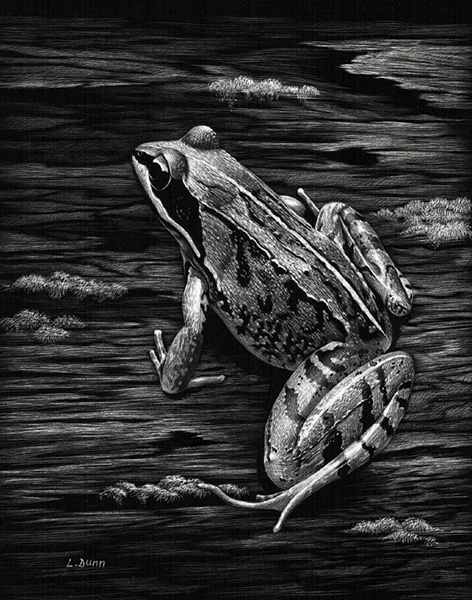LORI DUNN SCRATCHBOARD ART
promoting conservation through artistic efforts
Insert Headline
Woodland Gem
5 x 7
SOLD
My favourite of all our native amphibians, the wood frog (Rana sylvatica) is a very unique species. This forest dweller migrates long distances to breed in ephemeral wetlands. Conservationists pay close attention to the breeding behaviour of this species as these vernal pools are often more at risk than the frogs themselves.
What is truly remarkable, however, is its unique method of hibernation. After digging under the leaf litter before the onset of winter, the wood frog’s metabolism eases to a near halt, so its cells can survive on negligible amounts of oxygen and energy. Meanwhile, the liver begins to pump out glucose, raising concentrations in the bloodstream to more than 50 times those found in a human diabetic. Ice crystallizing in the frog’s body cavities draws some of the water from the cells in the flesh and organs. This further concentrates glucose inside the cells, turning it into an antifreeze that keeps the remaining water from solidifying. (Commercial antifreeze is made of a sugar alcohol similar to glucose, called ethylene glycol.)
With the antifreeze in its cells, a frog can remain in a torpid state until spring, when its metabolism springs back to life. Only a few species of animals in the world have this ability. Other ectothermic animals must hibernate below the frost line in order to survive.This “cryoprotectant” nature of the wood frogs blood has been studied endlessly in order to figure out a way to preserve human organs by freezing them before transplantation.
With it’s dark black eye mask, the wood frog is unmistakeable. I have several vernal wetlands near my property and often have juvenile wood frogs hopping about mid-summer. Their duck- like quacking is often the first frog call heard in the spring. This woodland gem is more than just your average frog!
